airbag AUDI S3 2009 Owners Manual
[x] Cancel search | Manufacturer: AUDI, Model Year: 2009, Model line: S3, Model: AUDI S3 2009Pages: 324, PDF Size: 76.02 MB
Page 4 of 324
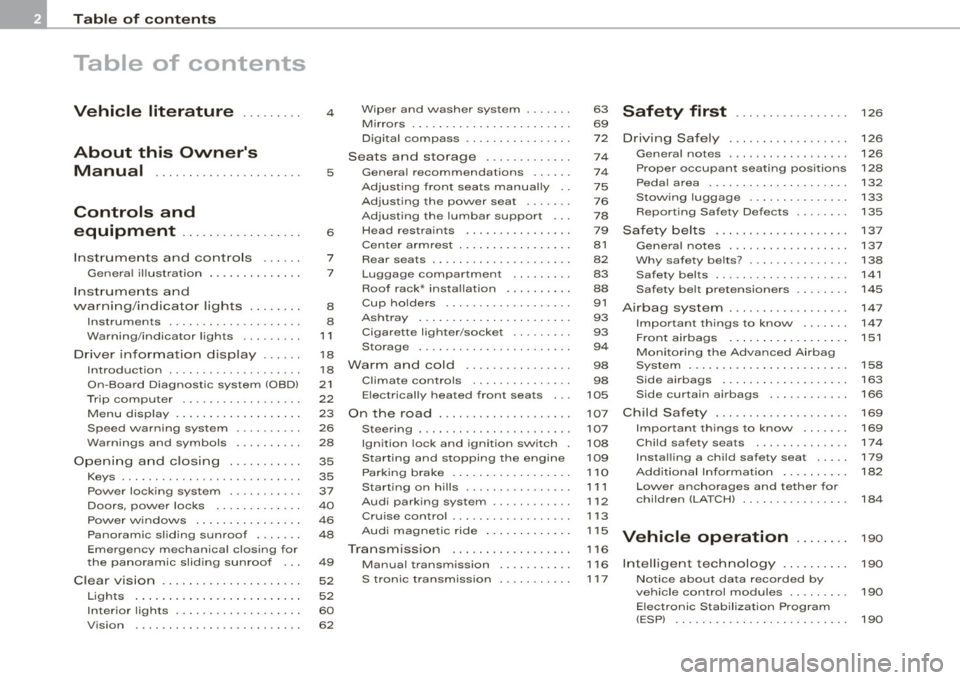
Table of contents
Table of contents
Vehicle literature ........ .
About this Owner's Manual ..... ... ...... ....... .
Controls and
equipment ................. .
Instrumen ts and con trols ..... .
Genera l ill ustration ............. .
Ins trumen ts and
warning/indicat or lig hts ....... .
Instruments ... .... ........... . .
Warning /indica tor lights ........ .
Driver in fo rma tion disp lay ..... .
Introduction ... .......... ... ... .
On -Board Diagnos tic system (OBD)
Trip compute r ................. .
Menu di splay ............ ...... .
Sp eed warn ing system ...... ... .
Warnings and symbo ls ......... .
Opening and c losi ng .......... .
Keys .............. ... ... ... ... .
Power locking system .......... .
Doors, power locks ............ .
Powe r w indows ... ... .. .... ... .
Panoramic s liding sunroof ...... .
Emergency mechanical c losing for
t he panoram ic slid ing sunroof .. .
Clear v ision ................ .... .
Lig hts . ..... ... ... .. .. ... ... .. .
Interior lights .................. .
Vision ........ ...... ......... . .
4
5
6
7
7
8
8
1 1
1 8
1 8
21
22
23
26
28
35
35
37
40
46
48
49
52
52
60
62
Wiper and washer system ...... .
Mirrors ....................... .
Digital compass ............ ... .
Seats and storage ............ .
General recommendat ions ..... .
Adjust ing front seats manua lly ..
Ad just ing th e power seat ...... .
Adjusting the lumbar support .. .
Head restraints ............... .
Cen ter armrest ... ... ... .. .. .. . .
Rear s eats .................... .
Luggage compartment . ...... . .
Roof rack* installation ......... .
Cup ho lders .......... ........ .
As htray ................ ...... .
Cigar ette light er/soc ket . .• .. .. ..
S torage ... ... ......... ... ... . .
War m and cold ........... ... . .
Clima te controls ....... ... .... .
Elect rically heated front seats . . .
On the road . .............. ... . .
S tee ring ...................... .
Ignition lock and ignition switch .
Sta rting and stopping the engine
Par king bra ke ................. .
Starting on hills ........ .• ... .. .
Audi parking system ... ... ..... .
Cr uise control ............ ..... .
Audi magne tic ride .. ... .. .. ... .
Transmission
Manual t ransm ission
S tronic transmiss ion . ... ...... .
63
69
72
7 4
7 4
7 5
76
78
7 9
81
82
83
88
91
93
93
94
98
98
105
107
107
108
109
1 10
1 11
1 12
1 13
1 15
1 16
1 16
1 17
Safety first ...... ...... .... .
Driving Safe ly ...... .... ... .... .
Genera l notes ...... ........... .
Proper occupant seating pos it ions
Peda l a rea .................... .
S tow ing luggage .......... .... .
R eporting Saf ety D efects ...•....
Safety belts ................... .
General notes ....... •..........
Why safety be lts? ..... ..... •....
Sa fety belts ........... ... .. ... .
Safety belt pretensioners ....... .
Airbag system ................. .
Important things to know ...... .
Front
airbags .. .... ... ...... .. .
Monito ring the Advanced Airbag
System ... ..... ... .. ..... ... .. .
Side a irbags .............. •....
Side curtain airbags ....... •....
C hild Safe ty ................... .
Important thi ngs to know ...... .
Child safety seats ............. .
Insta lling a ch ild safety seat .... .
Add itional Information .... ... .. .
Lower anchorages and tether for
child ren (LA TCH) ............... .
Vehicle operation ... ... . .
Intel ligent technology . ... .. .. . .
No tice abo ut da ta recorded by
ve hicle control modules .. ...... .
E lect ronic Stabili zation Program
(ESP) ......................... .
126
126
126
128
132
133
135
137
137
138
141
145
147
147
151
158
163
166
169
169
174
179
182
184
190
190
190
190
Page 9 of 324

Instruments and controls
General illustration
G)
0
©
©
©
©
0
©
®
Power window switches
Door handle
Power locking switch
Switches for:
- Adjuster for outside mirrors .. ........ ... ...... .
- Switching on heated exterior mirrors
Light switch .................................. .
Air outlets .... .... ... .. ............... ........ .
Turn signa l and high beam ...... ............. .. .
Radio control buttons
Steering wheel with:
- Integra ted control buttons (multi -function steering
wheel only) for Audi Sound System
-Horn
- Driver's airbag .............................. .
@ Instrument cluster .................... ...... ... .
@ Radio and telephone control buttons
@ Switches for
- Windshield wiper/washer .... ... .. ...... ... ... .
- Trip computer .... ................... ....... .
@ Depending on options: Radio or Navigation system
(navigation, radio, CD changer)
@ Switches for:
- Electronic Stabilization Program (ESP) .......... .
- Tire pressure monitoring system .. ... .. .... ... .
@ Emergency flasher ............................. .
@ Storage tray or switch for ... .... .... .... .... ... . .
- Audi parking system
Controls and equip
ment
46
41
70
52
104
59
151
8
63
22
190
264
95
95
112
Instruments and controls
@
@
@
@
@
@
@
-Audi magnetic ride .......................... .
G love compartment !lockable) ................... .
Front passenger's airbag
Loudspeaker (treble)
Climate controls ........ .... ... .. .... .... ...... .
Rear w indow defogger switch ...... .... ...... ... .
Switch for seat heating .... .... .... .... ........ . .
Gear shift lever or selector lever
- Manual transmission ......................... .
A t . . . -u omatIc transmIssIon ...................... .
@ Cup holder ...... ..... .. ...... ...... .... ... ... .
@ Electrical socket ................ ....... ........ .
@ Electrical socket ............................... .
@ AUX-in connection
@ Parking brake lever . ...... ...... ... .. .... .... .. .
@) Ign ition lock ............ ........ ........ ...... .
@) Adjustable steering column ...... ..... ...... .... .
@ Cruise control .... .... ........ ... .... .... ...... .
@ Instrument lighting ............................ .
@ Data Link Connector for On Board Diagnostic (OBD II)
@ Release lever for the engine hood ...... .... ...... .
@ Switches for:
- Fuel flap release ............................. .
- Rear hatch release
[ i ] Tips
12
95
151
100
105
105
116
117
91
93
93
110
108
107
113
57
21
224
221
42
A separate Owner's Manual is in vehic les that have a factory
installed radio, CD changer, navigation system, AUX-in connection
or mu ltifunction steering wheel. •
I • •
Page 14 of 324
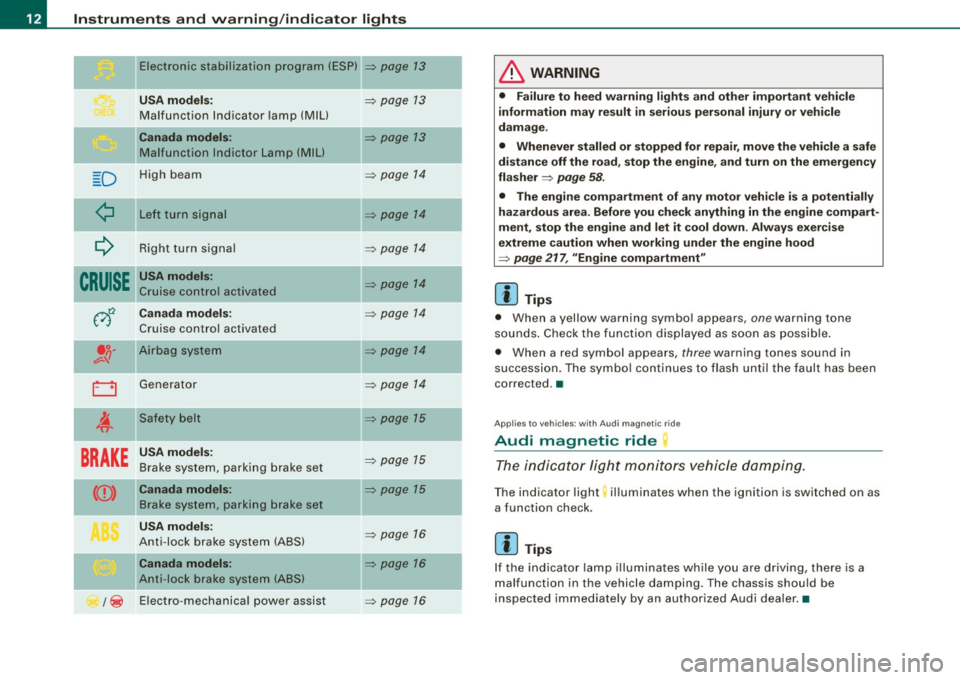
Instruments and warning/indicator lights
Electronic stabilization program (ESP) ~ page 13 & WARNING
USA models : ~ page 13 • Failure to heed warning lights and other important vehicle
Malfunction Indicator lamp (M IU information may result in serious personal injury or vehicle
--damage .
Canada models :
~ page 13
Whenever stalled or stopped for repair, move the vehi cle a safe Ma lfunction lnd ictor Lamp ( MIU •
distan ce off the road , stop the engine , and turn on the emergen cy
_D H igh beam ~ page 14 flasher ~ page 58.
-- -• The engine compartment of any motor veh icle is a potentially
¢ Le ft tu rn sig na l ~ page 14 hazardous area. Before you check anything in the engine compart -
ment , stop the engine and let it cool down . Alway s exer cise
c> Right turn signa l ~ page 14 extreme caution when working under the engine hood
~ page 217, "Engine compartment "
CRUISE
USA models: ~ page 14 Cruise control activated [ i ] Tips -
R~ Canada models : ~ page 14 • When a yellow warn ing symbo l appears, one warning tone
Cruise control activated sounds. C heck the function displayed as soon as possible.
-.o. Airbag syst em ~ page 14 • When a red symbol appears, three warning tones sound in v-q
succession . The symbo l continues to flash unti l th e fault has bee n
0 Generator ~ page 14 corrected. •
A v
Safety belt ~ page 15 Applies to vehic les: with Audi magnet ic r ide
BRAKE
USA models :
Audi magn etic rid e
~ page 15 Brake sy stem , park ing b ra ke set The indic ator ligh t monitors vehicle d amping .
((D) Canada models : ~ page 15 The indicator light • illuminates when the ignition is switched on as
Brake system, parking brake set
a function check.
USA models: ~ page 16 Anti-lock bra ke system (ABS) [ i ] Tips -Canada models : ~ page 16 If the indicator lamp illum ina tes wh ile you are d riving, the re is a
Anti -lock brake syst em (ABS) malfunction in the vehic le damping. The chassis shou ld be
/ ~ E
lectro -mechanica l power assist
~ page 1 6 inspected i mme diately by an aut hor ized Aud i d ea ler .•
Page 16 of 324
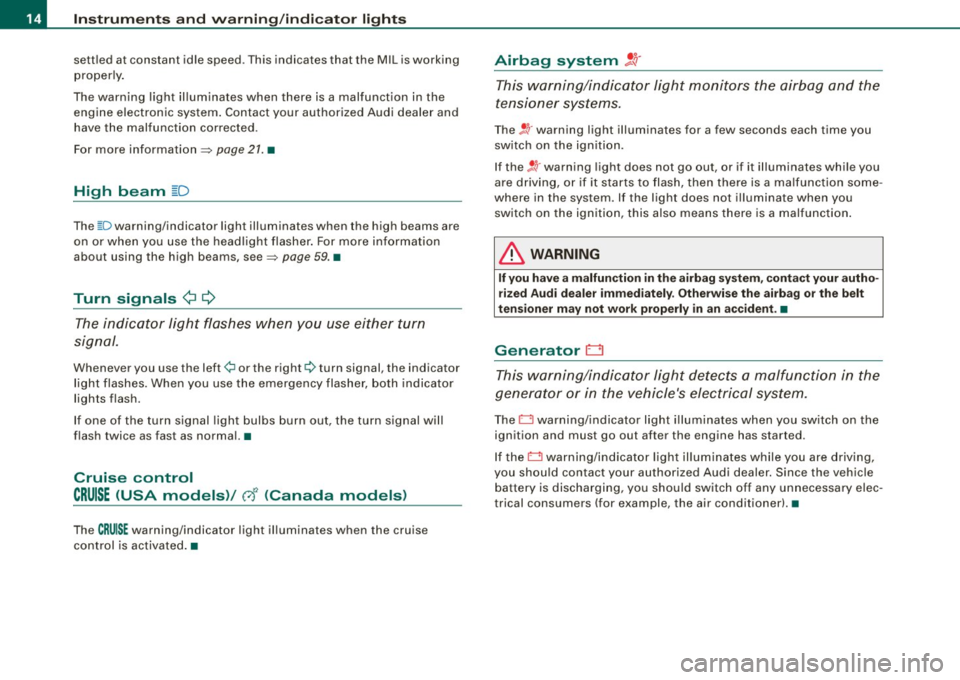
Inst rum ents and w arnin g/indi cat or li ghts
settled at constant idle speed . This indicates that the MIL is working
proper ly .
The warning light il luminates when there is a malfunction in the
engine electronic system . Contact your authorized Audi dealer and
have the malfunction corrected .
For more information~
page 21. •
High beam [D
The ~D warning/indicator light illuminates when the high beams are
on or when you use the head light flasher . For more information
about using the high beams, see~
page 59. •
Turn signals ¢ ¢
The indicator light flashes when you use either turn
signal .
Whenever you use the left¢ or the right¢ turn signal , the indicator
light flashes. When you use the emergency flasher, both indicator lights flash.
If one of the turn signal light bulbs burn out, the turn signal will
flash twice as fast as normal. •
Cruise control
CRUISE (USA models)/ c,)12 (Canada models)
The CRUISE warning/indicator light il lum inates when the cruise
control is activated. •
Airbag system !.!r
This warning/indicator light monitors the airbag and the
tensioner systems .
The !.!r warning light illuminates for a few seconds each time you
switch on the ignition.
If the
! .!r warning light does not go out, or if it illuminates while you
are driving, or if it s tarts to flash, then there is a ma lfunc tion some
where in the system . If the light does not illuminate when you
switch on the ignition, this also means there is a malfunction .
& WARNING
If you have a malfunction in the airbag sy stem, cont act y our auth o
r iz ed A udi dealer immed iate ly. Othe rwise the a irbag or th e belt
te nsio ner ma y not w ork properly in an acci dent . •
Generator 0
This warning/indicator light detects a malfunction in the
generator or in the vehicle's electrical system.
The D warning/indicator light i lluminates when you switch on the
ignition and must go out after the engine has started.
If the
D warning/indicator light illuminates while you are driving,
you should contact your authorized Audi dealer. Since the vehicle battery is discharging, you should switch off any unnecessary elec
trical consumers (for example, the air conditioner). •
Page 40 of 324
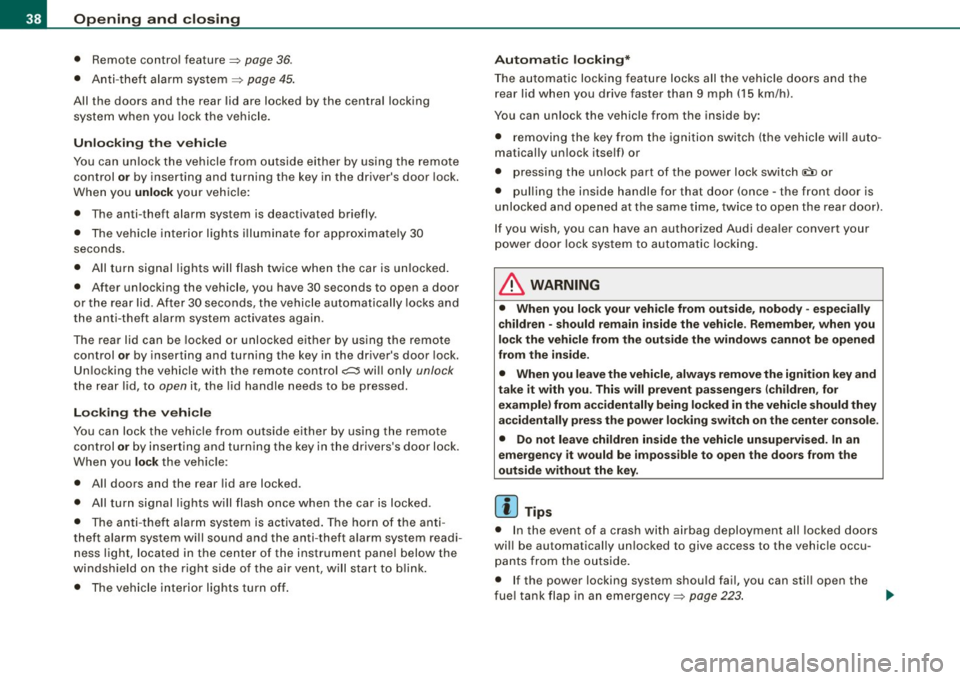
Openin g a nd clo sin g
• Remote control feature => page 36.
• Anti-theft alarm system=> page 45.
All the doors and the rear lid are locked by the central locking
system when you lock the vehicle.
U nlock ing th e vehic le
You can un lock the vehicle from outside either by using the remote
control
or by inserting and turning the key in the driver's door lock.
When you
unl ock your vehic le:
• The anti-theft alarm system is deactivated briefly .
• The vehicle interior lights i lluminate for approxima tely 30
seconds.
• All turn signal ligh ts will flash twice when the car is un locked .
• After unlocking the vehicle, you have 30 seconds to open a door
or the rear lid. After 30 seconds, the vehic le automatica lly locks and
the anti-theft alarm system activates again .
The rear lid can be locked or unlocked either by using the remote
control
o r by inserting and turning the key in the driver's door lock.
Un locking the vehicle with the remote control
c::::::5 wil l only unlock
the rear lid , to open it, the lid handle needs to be pressed.
Lo ckin g the vehicle
You can lock the vehicle from outside either by using the remote
control
or by inserting and turning the key in the drivers's door lock.
When you
lo ck the vehicle :
• All doors and the rear lid are locked .
• All turn signal lights will flash once when the car is locked.
• The anti -theft alarm system is activated . T he horn of the anti
theft alarm system will sound and the anti-theft alarm system readi ness l ight, located in the center of the instrument pane l below the
windshie ld on the right s ide of the air vent, will start to b link.
• The vehicle interior ligh ts turn off .
Automatic locking *
The automatic locking fea ture locks all the vehicle doors and the
rear lid when you drive faster than 9 mph (15 km/h).
You can unlock the vehicle from the inside by:
• removing the key from the ignition switch (the vehicle wi ll auto
matically un lock itself) or
• pressing the unlock part of the power lock switch
oc:"D or
• pulling the inside handle for that door (once - the front door is
unlocked and opened at the same time, twice to open the rear door).
If you wish, you can have an authorized Audi dealer convert your
powe r door lock sys te m to automatic locking.
& WARNING
• When you lock your vehicle from out side , nobody -esp ecia lly
c h ildr en - s hould r em ain in sid e the vehi cle . R emember , when you
lock the vehicle from the out side the window s ca nnot be opened
fr om t he in side .
• When you leave the vehicle , alway s remo ve the ignition key and
t a ke it with you . Thi s w ill pre vent p assengers (children , for
ex ampl e) from a ccidentall y being lock ed in the vehicle should they
a cc ident ally pre ss t he powe r lock ing switc h on t he center consol e.
• Do not leave children in side the vehicle un supe rvi se d. In an
emerg ency it w ould be impos sible t o ope n th e door s from the
out side without the key.
[ i ] T ips
• In the event of a crash with airbag deployment all locked doors
wi ll be automatical ly un locked to give access to the vehic le occu
pants from the outs ide .
• If the power locking system shou ld fai l, you can stil l open the
fue l tank flap in an emergency=>
page 223. ~
Page 43 of 324

& WARNING
Alw ays rea d and he ed W ARNIN G => 6 in "Genera l descripti on" on
page 37. •
Locking and unlocking the vehicle from inside
The vehicle can be locked or unlocked from the inside
using the power locking switches located in the driver's
and the front passenger's door.
F ig . 2 8 Dri ver's do or:
powe r locking switch
In addition to t he central locking switches in t he doors,
there is a locking switch on the rear center console for the
rear -seat passengers
~ page 42 .
How to lo ck all doors and the rear lid
simultaneously
- P ress lower part of t he power locking switch m ~ fig. 28
~ & -
How to unlo ck all doors and the rear lid
s imultan eo usly
- Press the upper part of the switch m .
Controls and equip
ment
Opening and clo sing
How to unlo ck / op en eac h front door separat ely
using th e door handle
- Pull the door handle once to release the lock and simul -
taneously ope n the door.
How to un lock / open each r ear door separat ely
using th e door handle
- Pull the doo r handle once to release the lock.
- Pull the handle
twice to open the door.
If you lock the vehicle using the pow er lockin g swit ch G'.i, please note
the following :
• You cannot open the doors or the rear lid from the
outside
(inc reased security, for examp le when you are stopped at a red
light) .
• The diode in the power locking switch i lluminate when a ll the
doors and the rear lid are closed and locked .
• You can unlock and open the doors individually from the inside
by pulling o nce on the door hand le for the front doors and twice for
the rear doors.
• If the driver's door is opened (a fter you have locked the vehicle
from the inside using the power locking switch), the door will
remain un locked to prevent you from locki ng yourself out of your
vehicle. After you close the door, you have to lock the d river 's door
again .
• If you have a crash and the airbag is activated, the doors au to
matically un lock .
& WARNING
• If you u se the power l ock ing switch w ith the door s clo sed ,
r e memb er t ha t all the vehic le doors will lo ck .
• Locking door s from th e in side c an h elp pr event inadv ertent
do or op en in g durin g an accident and can also prevent un want ed ...
I • •
Page 60 of 324

Clear vision
Igniti on ON , light swit ch at ::oo: or fD .
With the lights switched on, the brightness of instrument cluster
!i.e . needles, gauges and displays) and center console il lumination
can be adjusted.
0 Note
The instrument cluster and cent er console illumina tion (gauges and
needles) comes on when you swi tch on the igni tion and the
vehi cle
h eadlights are off .
Be aware of the following difference between
models built to US or Cana dian speci fica tions :
• USA model s: illumination of the in strument clu ster (gauges and
needle s), dash and center con sole around the gear shift lever i s
c o ntrolled by a light sensor lo cated in the instrument panel. The
i n strument panel ill umination will automatically become dimmer
a s th e daylight fades awa y and eventu ally w ill go out completel y
when outside l ight i s very low . Thi s is to remind you , the driver , to
swi tch on the headlight s befo re it get s to o dar k.
• Canada models: in strument panel illumination will stay bright
re gardle ss of the i ntens ity of ambient light . Al wa ys be aware of
change s in out sid e light conditi ons while you are d riving. Re spond
i n time t o fading daylight by turn ing the light swit ch to posit ion
fD
(or "AUTO" if your car is equipped with this feature) to turn on your
headlights . •
Ap plies to vehi cles: with b i-xeno n headli ghts
Bi-Xenon headlights*
After starting the engine, the bi -xenon headlights are automatica lly
adjus ted to the load and angle of the vehic le (for example , during
acce lerat ion and brak ing) . This prevents oncoming traffic fro m
experiencing unnecessary headlight g lare from your bi-xenon head
lights .
If the system is not operating properly, a warning symbol in the
Auto -Check Control is displayed ::::;,
page 33. •
Emergency flasher ~
The emergency flasher mak es othe r moto rists aware that
you or your vehicle are in an emergency situation.
1 1 Q
-
II D ll1
[ Ii J
a
l 'l
"' " "'
J
Fi g. 5 4 Cen ter
co nso le : em erge ncy
fl as her swi tc h
Press the sw itch ~==>fig. 54, to sw itch the emergency
flas her on or off.
When the emergency flasher is on, al l four turn signal blink at the
same time. The turn signal indicator lights¢ Q in the inst rument
cluster, as we ll as the light in the emergency flasher switch~ blink
l ikew ise.
The emergency flasher will automatically switch on if you are in an accident where the airbag has deployed .
[ i ] Tips
You should switch on the emergency flasher when :
• you are the last vehicle standing in a traffic jam so that any other
veh ic les coming can see you, or when
• your vehic le has broken down or you are in an emergency situa
tion, or when
• your vehicle is being towed by a tow truck or if you are towing
another vehicle behind you. •
Page 76 of 324
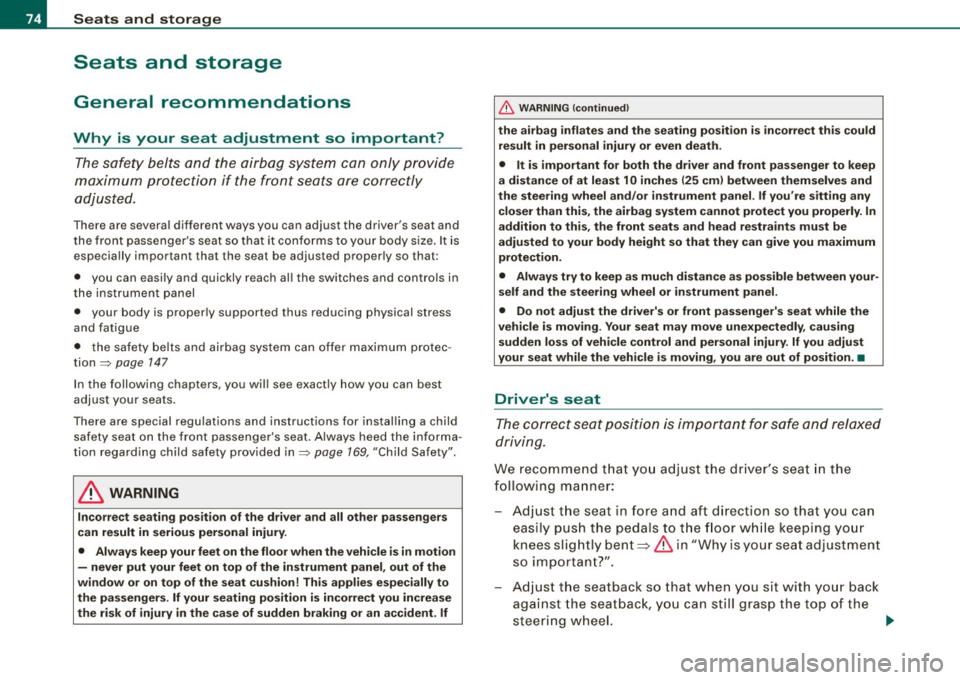
Seats and storage
Seats and storage
General recommendations
Why is your seat adjustment so important?
The safety belts and the airbag system can only provide
maximum protection if the front seats are correctly
adjusted.
There are several different ways you can adjust the driver's seat and
the front passenger's seat so that it conforms to your body size. It is
especially important that the seat be adjusted properly so that:
• you can easily and quickly reach all the switches and controls in
the instrument panel
• your body is properly supported thus reducing physical stress
and fatigue
• the safety belts and airbag system can offer maximum protec
tion=>
page 147
In the following chapters, you will see exactly how you can best
adjust your seats.
There are special regulations and instructions for installing a child safety seat on the front passenger's seat. Always heed the informa
tion regarding child safety provided in=>
page 769, "Child Safety".
L1}. WARNING
Incorrect seating position of the driver and all other passengers
can result in serious personal injury.
• Always keep your feet on the floor when the vehicle is in motion
- never put your feet on top of the instrument panel, out of the
window or on top of the seat cushion! This applies especially to
the passengers. If your seating position is incorrect you increase
the risk of injury in the case of sudden braking or an accident. If
& WARNING (continued)
the airbag inflates and the seating position is incorrect this could
result in personal injury or even death.
• It is important for both the driver and front passenger to keep
a distance of at least 10 inches (25 cm) between themselves and
the steering wheel and/or instrument panel. If you're sitting any closer than this, the airbag system cannot protect you properly. In
addition to this, the front seats and head restraints must be
adjusted to your body height so that they can give you maximum
protection.
• Always try to keep as much distance as possible between your
self and the steering wheel or instrument panel.
• Do not adjust the driver's or front passenger's seat while the
vehicle is moving . Your seat may move unexpectedly, causing
sudden loss of vehicle control and personal injury. If you adjust
your seat while the vehicle is moving, you are out of position. •
Driver's seat
The correct seat position is important for safe and relaxed
driving.
We recommend that you adjust the driver's seat in the
following manner:
- Adjust the seat in fore and aft direction so that you can easily push the pedals to the floor while keeping your
knees slightly bent=>
& in "Why is your seat adjustment
so important?".
- Adjust the seatback so that when you sit with your back
against the seatback, you can still grasp the top of the
steering wheel.
~
Page 77 of 324
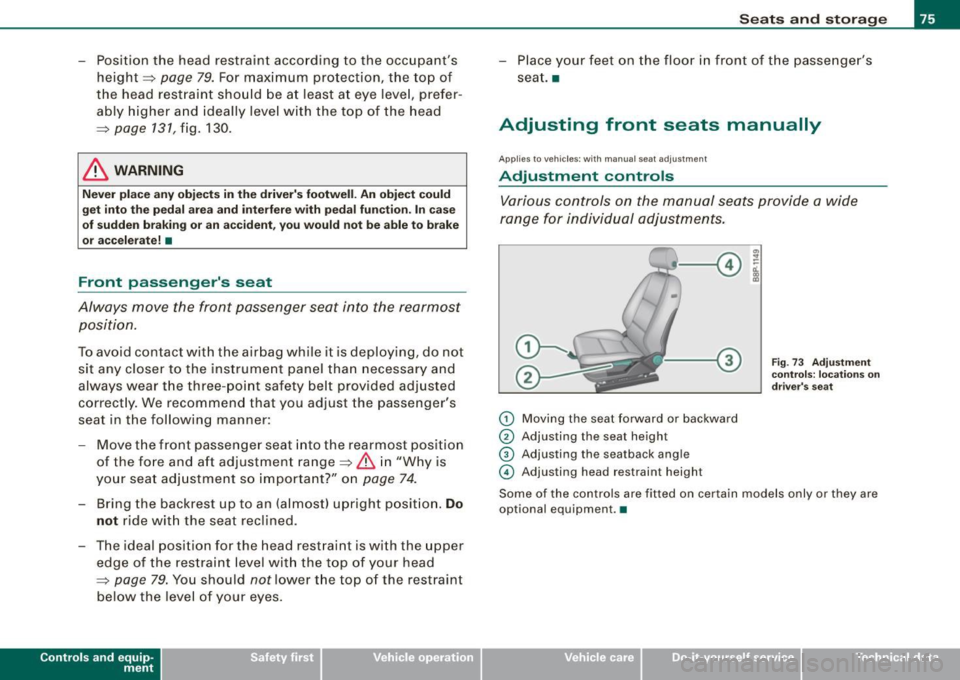
- Position the head restraint according to the occupant's height=> page
79. For maximum protection, the top of
the head restraint should be at least at eye level, prefer
ably higher and ideally level with the top of the head
=> page 131 , fig. 130.
& WARNING
Never place any objects in the driver's footwell. An object could
get into the pedal area and interfere with pedal function. In case
of sudden braking or an accident, you would not be able to brake
or accelerate! •
Front passenger's seat
Always move the front passenger seat into the rearmost
position.
To avoid contact with the airbag while it is deploying, do not
sit any closer to the instrument panel than necessary and
always wear the three-point safety belt provided adjusted
correctly. We recommend that you adjust the passenger's
seat in the following manner :
- Move the front passenger seat into the rearmost position
of the fore and aft adjustment range=>
& in "Why is
your seat adjustment so important?" on page
74.
-Bring the backrest up to an (almost) upright position. Do
not ride with the seat reclined.
- The ideal position for the head restraint is with the upper
edge of the restraint level with the top of your head
=> page
79. You should not lower the top of the restraint
below the level of your eyes.
Con tro ls and eq uip
ment
Seats and storage
- Place your feet on the floor in front of the passenger's
seat. •
Adjusting front seats manually
Applies to vehicle s: wi th manua l seat ad justme nt
Adjustment controls
Various controls on the manual seats provide a wide
range for individual adjustments.
G) Moving the seat forward or backward
© Adjusting the seat height
© Adjusting the seatback angle
© Adjusting head restraint heigh t
Fig. 73 Adjustment
controls: locations on
driver's seat
Some of the controls are fitted on certain models only or they are
optional equipment. •
Vehicle care
I I irechnical data
Page 78 of 324
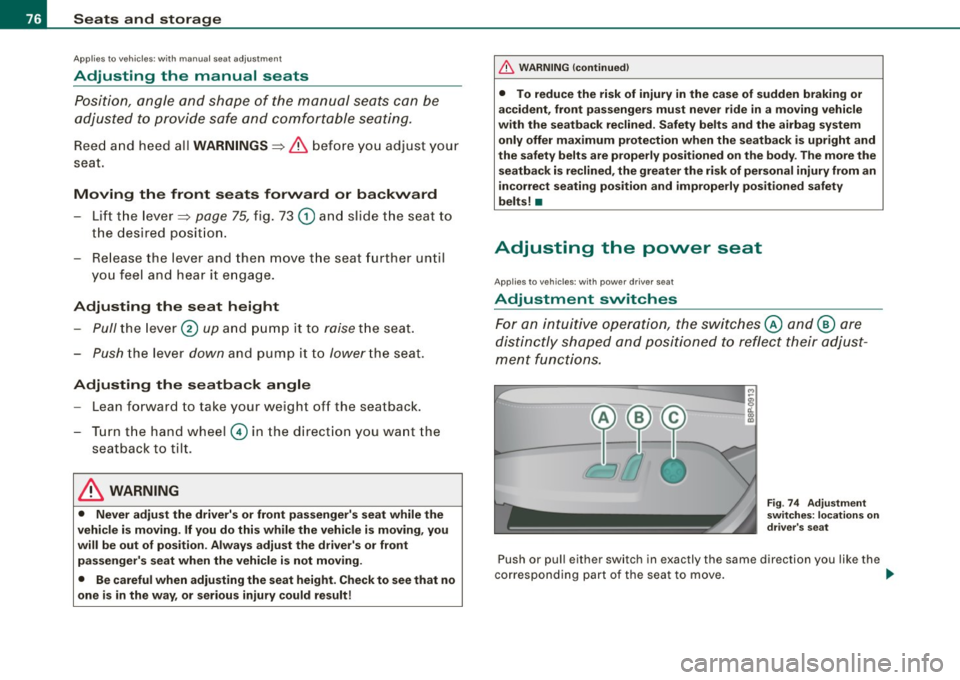
Seats and storage
Applies to vehicles : w ith m anual seat a djustm en t
Adjusting the manual seats
Po sition, angle and shape of the manual seats can be
adjusted to provide safe and comfortable seating.
Reed and heed all WARNINGS =:> & before you adjust your
seat.
Moving the front seats forward or backward
- Li ft the lever =:>
page 75, fig. 73 (D and slide the seat to
the desired p osition.
- Release the lever and then move the seat further until
you feel and hear it engage.
Adjusting the seat height
- Pull the lever @ up and pump it to raise the seat.
-Push the lever down and pump it to lower the seat .
Adjusting the seatback angle
- Lean forward to take your weight off the seatback.
- Turn the hand wheel© in the direction you want the
seatback to tilt.
& WARNING
• Never adjust the driver's or front passenger's seat while the
vehicle is moving . If you do this while the vehicle is moving , you
will be out of position . Always adjust the driver's or front
passenger's seat when the vehicle is not moving .
• Be careful when adjusting the seat height . Check to see that no
one is in the way, or serious injury could result!
& WARNING (continued)
• To reduce the risk of injury in the case of sudden braking or
accident, front passengers must never ride in a moving vehicle
with the seatback reclined. Safety belts and the airbag system
only offer maximum protection when the seatback is upright and
the safety belts are properly positioned on the body . The more the
seatback is reclined, the greater the risk of personal injury from an
incorrect seating position and improperly positioned safety
belts! •
Adjusting the power seat
Applies to vehi cles : wi th p ow er dr iv e r s eat
Adjustment switches
For an intuitive operation, the switches @ and @ are
distinctly shaped and posi tioned to reflect their adjust
ment functions.
Fig . 7 4 Adjustment
switches: locations on
driver's seat
Push or pul l either switch in exactly the same direction you like the
co rresponding part of the seat to move. .,,